Snake Plant Overwatered Vs Underwatered: Causes & Solutions
It is important to water the snake plants only when the top soil feels dry, as both underwatering and overwatering can damage the plant beyond repair.
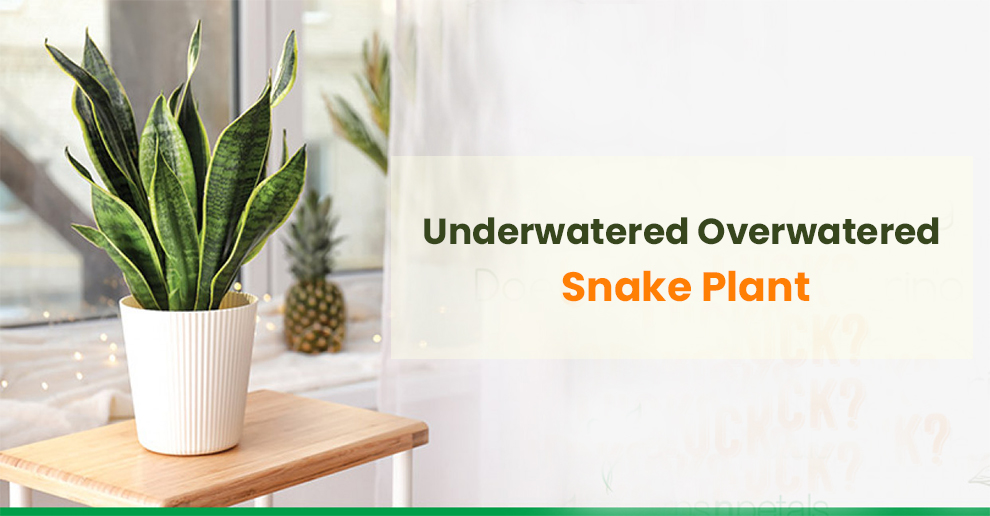
Snake plants, also known as Sansevieria, have leaves that are typically thick and succulent, with a green color that can range from light to dark, and often have yellow or white stripes or markings. The leaves grow vertically and can reach up to several feet tall, depending on the variety.
An underwatered overwatered snake plant may exhibit symptoms such as stunted snake plant’s growth, leaves curling, yellowing mushy leaves, brown brittle leaves, or root damage with foul smell, which can be addressed through proper watering techniques and soil management.
When a snake plant is overwatered, the leaves may start to wilt or droop and the tips may turn brown or yellow. The plant may also develop root rot, which can cause the leaves to become mushy or slimy. In severe cases, the plant may die.
On the other hand, when a snake plant is underwatered, it starts to wilt. The leaves may become dry and brittle, and the tips may turn brown or yellow. The plant may go into a state of dormancy in an attempt to conserve water.
While snake plant varieties are drought-tolerant and can survive periods of dryness, they still require regular watering to thrive.
In this article, you will read about how overwatered and underwatered Snake plants look like, how to prevent overwatering or underwatering problems, and how to recover the plant once it has been overwatered or underwatered.
Snake Plant Overwatered Vs. Underwatered Symptoms
| Symptoms | Overwatered | Underwatered |
| Leaves | Wilted or yellowing, Mushy or swollen | Wrinkled or shriveled |
| Root | Soft or mushy | Dry and brittle |
| Soil | Wet or soggy | Dry and pulling away from the pot |
| Growth | Slow or stunted | Slow or stunted |
| Appearance | Drooping or limp | Curled or brittle |
| Smell | Moldy or Foul | Earthy and Musty |
| Pests/Diseases | High risk of fungal growth and pest infestations | High risk of pest infestations |
| Recovery | Moderate to difficult | Moderate to easy |
What Does An Overwatered Snake Plant Look Like?
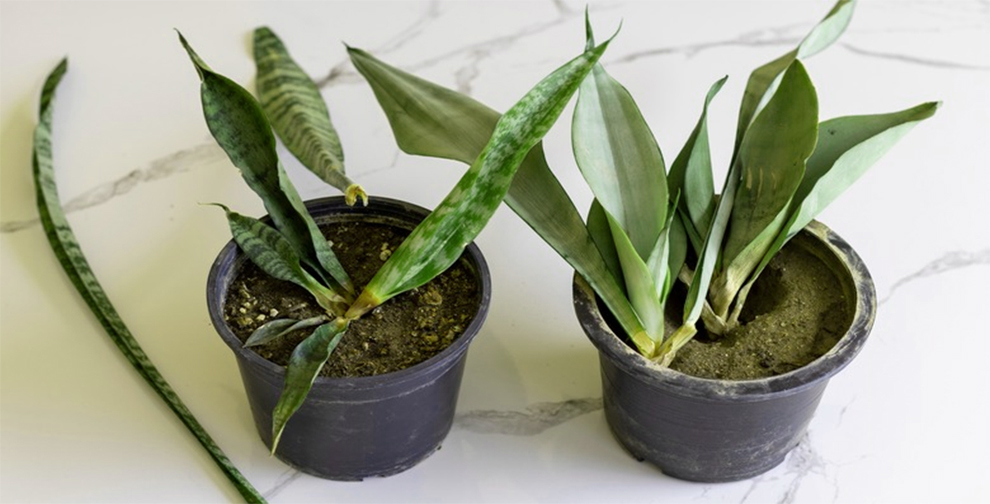
Overwatering a snake plant can lead to various symptoms that can harm the plant’s health. Here are some signs of an overwatered snake plant:
Moldy soil: If the soil of your snake plant remains moist for an extended period, it can develop mold. This mold can appear white, green, or black and can damage the plant’s roots.
Drooping leaves: Overwatering can cause the leaves of the snake plant to droop and become soft. The leaves may also look lighter in color than usual.
Yellow-brown leaves: Too much water can cause the leaves to turn yellow or have brown spots on snake plants. This occurs because the roots are not getting enough oxygen, which affects the plant’s ability to absorb nutrients.
Mushy leaves: When you touch the leaves of an overwatered snake plant, they may feel soft and mushy. This can indicate that the plant is rotting.
Flies around the plant: Overwatering can create a breeding ground for fungus gnats, which are small black flies that swarm around the plant.
Root rot: Overwatering can lead to root rot, a condition that damages the plant’s roots, making it difficult for them to absorb nutrients.
Damp moldy soil: Overwatering can cause the soil to remain damp, creating an ideal environment for mold and fungus to grow.
Foul odor: An overwatered snake plant may give off a foul odor due to the excess water causing the soil to decay.
What Does An Underwatered Snake Plant Look Like?
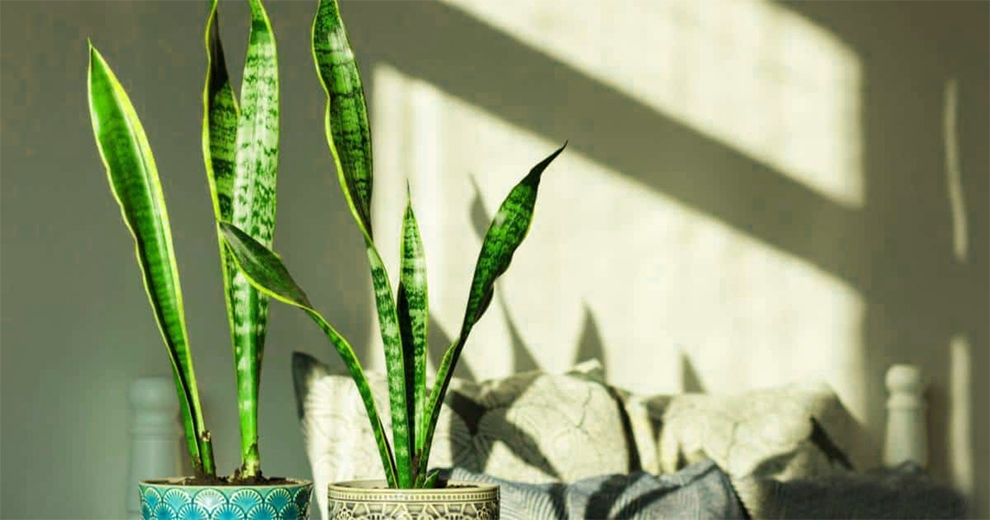
An underwatered Snake plant may display several physical signs that indicate it is not receiving enough water. Here is how an underwatered Snake plant can appear:
Wrinkled leaves: When your plant is not receiving enough water, the leaves of the snake plant can become curled, wrinkled or shriveled. This is because the plant is trying to conserve water by reducing the surface area of its leaves.
Curly leaves: Another sign of underwatering is curled leaves. The leaves of an underwatered Snake plant may curl up and become brittle as a way to conserve moisture.
Dry soil: Underwatering can cause the soil to become dry and pull away from the sides of the pot. This is because the plant is not taking up enough water to keep the soil moist.
Stunted growth: When a Snake plant is underwatered, it may stop growing or become stunted. This is because the plant is conserving energy and focusing on survival rather than growth.
Brittle roots: Underwatering can cause the roots of a Snake plant to become dry and brittle. This can make it difficult for the plant to absorb water even if it is watered properly in the future.
Snake Plant Overwatering Vs. Underwatering Treatment Options
Both underwatered and overwatered snake plants can be challenging to revive. Here are some treatment options for an overwatered snake plant:
Adjust your watering frequency: Overwatering is often caused by watering the plant too frequently. Check the soil moisture level regularly and water only when the soil has completely dried out.
Move the plant to a sunny location: Snake plants prefer bright, indirect light. Placing the plant in a sunny location will help dry out the soil more quickly and prevent overwatering.
Cut the rotted leaves: If the leaves have already started to rot, it is important to remove them as they can spread the rot to other parts of the plant. Use clean and sharp scissors to cut the affected leaves at the base.
Clean the roots and repot the plant: Remove the plant from its pot and inspect the roots. If they are brown and mushy, it’s a sign of root rot. Gently remove any rotted roots and clean the remaining healthy roots with a brush. Repot the plant in fresh, well-draining soil.
Make sure the pot has drainage holes: A pot without drainage holes can cause water to accumulate at the bottom, leading to root rot. Ensure that the pot has drainage holes to allow excess water to escape.
Change the soil if it is compacted: Compacted soil can prevent water from draining properly and lead to overwatering. Use fresh potting soil that is well-draining and porous.
Choose the correct pot size: Any severely underwatered overwatered snake plant will need you to switch to a new pot. The pot should be slightly larger than the plant’s root system to allow for growth.
Too large of a pot can cause overwatering, as excess soil can hold more water than the plant needs.
Make sure the humidity levels are not too high: Snake plants prefer low to moderate humidity levels. If the air is too humid, it can cause the soil to stay moist for too long and lead to overwatering.
Choose the right pot material: The potting material can also affect how quickly the soil dries out. Terracotta pots are porous and allow for better air circulation, which can help prevent overwatering. Plastic pots are less porous and can retain more moisture, leading to overwatering.
Snake plants are known for their hardiness and resilience, but they can still suffer from underwatering. Here are some treatment options to address this issue and enjoy the benefits of a snake plant for longer:
Cut the brown tips: If your snake plant is showing signs of dehydration, such as brown tips or wilting leaves, you can trim off the brown parts with a clean, sharp pair of scissors or pruning shears. This will help the plant conserve energy and redirect resources to healthy parts.
Make a proper watering schedule: To prevent underwatering in the future, it’s important to establish a proper watering schedule.
Snake plants prefer to dry out between waterings, so it’s best to wait until the soil is completely dry before watering again. Depending on your home’s humidity, temperature, and other factors, this could be anywhere from every 1-2 weeks.
Use the correct pot type: Choosing the right pot is also important for snake plant care. These plants prefer well-draining soil and pots with drainage holes to prevent water from accumulating and causing root rot. Also, the pot fabric should not cause excessive water loss.
Don’t use tap water: Snake plants are sensitive to chemicals in tap water, so it’s best to use filtered or distilled water to avoid the buildup of salts and minerals in the soil. So, for both underwatered overwatered snake plants, it is best to skip using tap water.
Move the plant away from the direct sun: Direct sunlight can cause snake plant leaves to dry out and curl up, so it’s important to move the plant to a shadier location if it’s getting too much sun.
Change the dry soil: If the soil has become too dry and compacted, it may be difficult for the plant to absorb water. To help the plant recover, gently loosen the soil around the roots and replace it with fresh, moist soil.
Mist the plant: Misting the leaves with a spray bottle can help provide some extra moisture and improve humidity levels around the plant.
Do not fertilize them immediately: When a snake plant is suffering from underwatering, it’s best to avoid fertilizing it right away. Wait until it has fully recovered before introducing any snake plant fertilizers, as the plant may not be able to absorb nutrients properly until it has regained its strength.
Soak it: If your snake plant is severely dehydrated, you can give it a thorough soak by placing it in a container of water for about an hour. This will help the roots absorb water and rehydrate the plant.
However, be careful not to leave the plant in water for too long, as this can cause overwatering and other issues.
Related: Snake Plant Growth Rate | How To Make Your Snake Plant Grow Faster | Do Snake Plants Flower
Snake Plant Overwatered Vs. Underwatered – Which One Is More Difficult To Recover?
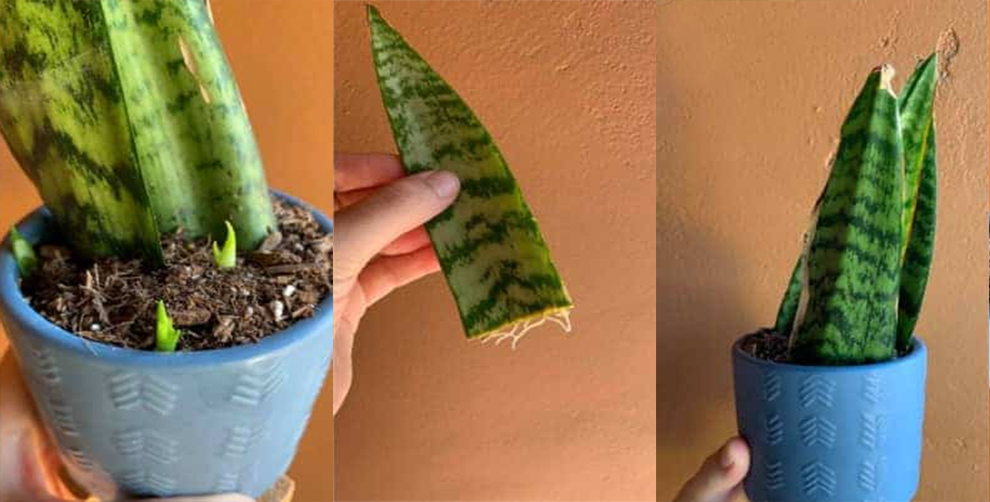
Both overwatering and underwatering can be detrimental to the health of the Snake plant, but overwatering is generally considered to be more difficult to recover from than underwatering.
Hence, you must know exactly how often to water your snake plants. When a Snake plant is overwatered, the roots can become waterlogged and start to rot, which can be difficult to detect until it’s too late. Over time, the rotting roots will be unable to absorb water and nutrients, which can cause the plant to wilt and die.
It may be possible to save an overwatered Snake plant by removing it from the pot, trimming away any rotted roots, and repotting it in fresh, well-draining soil. However, the success rate of this approach depends on the severity of the damage and how quickly the problem was detected.
In contrast, an underwatered Snake plant may be easier to save. When a plant is underwatered, it can be revived by watering it thoroughly and ensuring that it receives adequate water going forward.
The leaves may take some time to recover and may remain brown and crispy, but new growth should eventually appear.
Why Is It Important To Make Sure Overwatering & Underwatering Do Not Happen?
An underwatered overwatered snake plant can have wilted leaves, brown tips, or even root rot if left untreated for too long. It is important to ensure that the Snake plant is neither overwatered nor underwatered because this can have a negative impact on the plant’s health.
In addition to affecting the plant’s health, overwatering and underwatering can also impact its growth and appearance. Overwatered plants may become stunted or fail to produce new growth, while underwatered plants may become spindly and weak.
Additionally, overwatering or underwatering can increase the likelihood of pest infestations or fungal growth, which can further damage the plant.
Watering Tips To Prevent Over and Underwatering
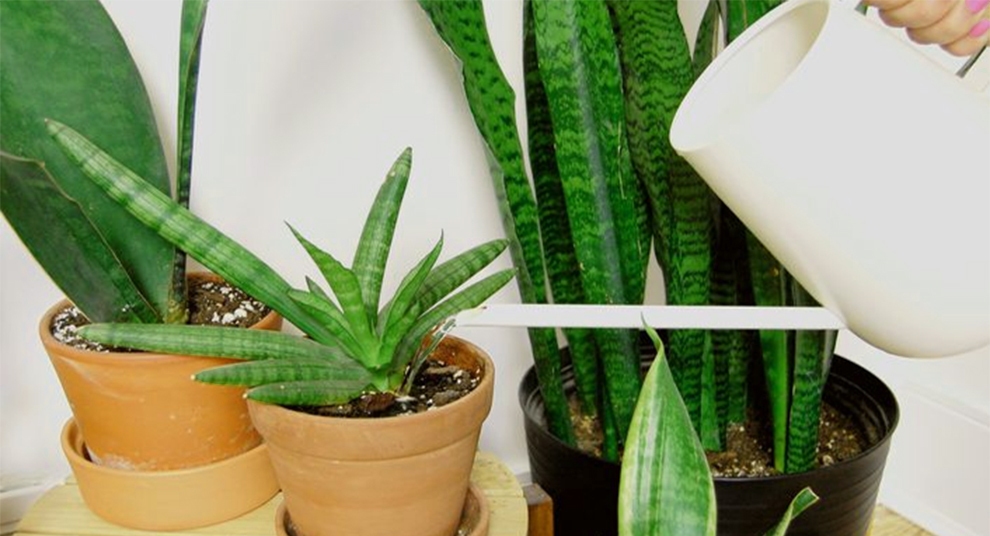
Here are some tips to prevent overwatering your snake plant:
- Choose a well-draining potting mix. A well-draining potting mix will allow excess water to drain away from the roots and prevent them from sitting in water.
- A pot with drainage holes will allow excess water to escape from the bottom of the pot. This will prevent the roots from sitting in standing water and reduce the risk of overwatering.
- Snake plants prefer to dry out between watering, so allow the soil to dry out completely before watering again.
- It is best to water your snake plant from the bottom. Simply fill a saucer with water and place the pot on top, allowing the soil to soak up the water from the bottom.
- You can check the soil moisture by sticking your finger into the soil. If the top inch of soil feels dry, it’s time to water your plant.
- Do not let the soil become bone dry or excessively wet; maintain a consistent level of moisture.
Understanding the differences between snake plant overwatering vs. underwatering is crucial for ensuring proper care and preventing common issues such as root rot or dehydration.
If you plan on bringing a snake plant home, here are some disadvantages of the snake plant you must know beforehand.
